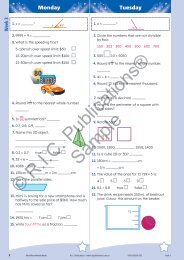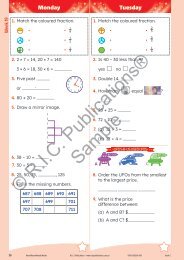PR-0552UK Primary Science - Book 2
Create successful ePaper yourself
Turn your PDF publications into a flip-book with our unique Google optimized e-Paper software.
Minibeast hunt<br />
Caring for my locality ~ Activity 2<br />
Objective<br />
• observe and develop an<br />
awareness of living things in a<br />
range of habitats in local and<br />
wider environments<br />
Working scientifically<br />
• Questioning<br />
• Observing<br />
• Predicting<br />
• Investigating and experimenting<br />
• Recording and communicating<br />
Designing and making<br />
• Exploring<br />
• Making<br />
Background information<br />
The purpose of this topic is to<br />
use a small animal or insect<br />
to develop observation and<br />
experimenting skills in the pupils.<br />
The animal selected is secondary in<br />
importance; however, the following<br />
guidelines should be adhered to<br />
and made clear to pupils.<br />
(i) All care should be taken when<br />
observing and collecting<br />
minibeasts.<br />
(ii) If minibeasts are to be collected,<br />
suitable storage should be used<br />
and the minibeasts released as<br />
soon as activities are complete.<br />
(iii) Collect only enough minibeasts<br />
as required.<br />
(iv) Some insects can sting. Avoid<br />
direct contact at all times.<br />
Minibeasts suitable for this topic<br />
include worms, slugs, snails,<br />
woodlice, grasshoppers, beetles,<br />
flies, caterpillars, butterflies.<br />
Before the lesson<br />
Materials needed<br />
• Jars with lids, nets, clipboards, notepaper, reference materials for use in<br />
identifying minibeasts.<br />
Preparation<br />
• Identify suitable locations in the school environment to collect and observe a<br />
variety of minibeasts.<br />
• Organise pupils in groups.<br />
The lesson<br />
Stimulus<br />
• Explain to pupils that the lesson will entail going on a ‘hunt’ to observe and<br />
collect a variety of minibeasts. Discuss with the pupils the definition of minibeasts<br />
and explain clearly their correct treatment.<br />
What to do<br />
• Review the worksheet so pupils are aware of the recording needed. During the<br />
hunt, notes and diagrams should be recorded on notepaper.<br />
• Have pupils go to an allocated area and observe and collect two different<br />
minibeasts.<br />
• Each group returns to class and completes the worksheet, transferring notes<br />
and drawing a picture.<br />
• Discuss the findings and observations of each group. Identify minibeasts collected<br />
and decide if it is possible to keep the insects for further observation or whether<br />
they should be returned to the environment.<br />
After the lesson<br />
Answers<br />
• Teacher check<br />
Additional activities<br />
• Classify the different minibeasts into categories based on shape, size, movement,<br />
colour etc.<br />
• Build adequate shelters for selected minibeasts.<br />
Viewing Sample<br />
Display ideas<br />
• Take photographs of pupils ‘hunting’ and observing minibeasts. Display the<br />
completed worksheets with the photographs and a caption written by the<br />
pupils.<br />
102 <strong>PR</strong>IMARY SCIENCE ~ Prim-Ed Publishing ~ www.prim-ed.com


















